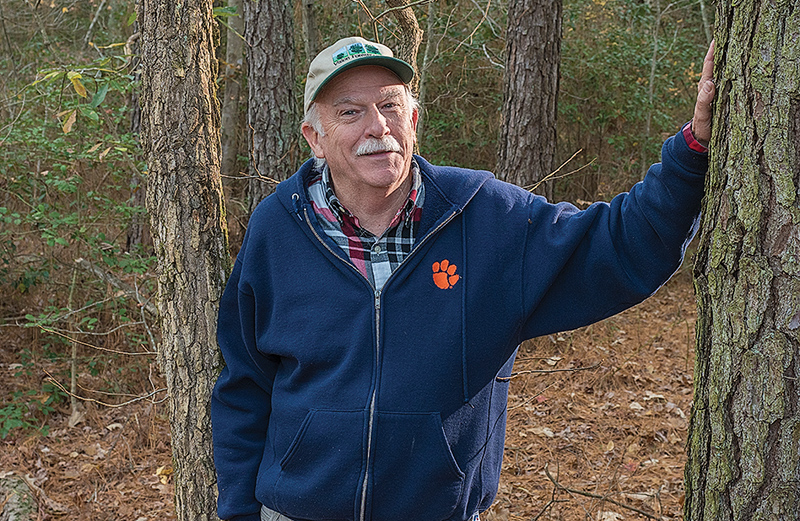By Tom Horton
Bay Journal
It was a chilly November morning, the rising sun sloshing light on the tree tops. Larry Walton and I were about half a mile into the woods that line the Nanticoke River near Vienna, Md., when he wrapped his arms around a great old Atlantic white cedar.
That tree species once shaded thousands of acres of Delmarva Peninsula swamps with its dense, evergreen canopies, until rampant logging and wetlands destruction made cedars relatively rare. Today, you seldom see specimens like this.
I was about to kid my friend Larry, a career commercial forester, that he’d become a tree hugger as he approaches retirement at age 65. But he was just measuring the massive, columnar trunk to see how much wood the cedar’s added since he was here some years ago.
“(I) used to be able to reach around it; not now,” Larry said.
But I also know he was happy to see that cedar thriving, standing tall, promising to thrill hikers here long after he and I are gone.
It’s never been ‘hug or log’
With Larry, it’s never been “hug or log” or “for us or against us.” Maybe that’s why his recent farewell party was a unique assemblage of the region’s logging community and a number of environmentalists. Only for Larry, I thought.
He could have cut that big cedar and others like it anytime during the years he managed around 60,000 acres of woodlands and wetlands around the Bay’s tidal rivers for Chesapeake Forest Products, a Virginia-based commercial timber corporation.
The company surely was not shy about clear-cutting or the almost complete leveling of the forests it owned hereabouts. That’s simply the most effective way to harvest the predominantly pine stands that are the mainstay of commercial timbering in this region.
Clear-cuts, to most non-timber people, are visually shocking, ugly. Far less apparent was what Larry and Chesapeake were electing not to cut, which included some beautiful forests and magnificent trees, including woods buffering tidal creeks and rivers like the Nanticoke and Pocomoke.
Where we were hiking could easily have been a giant sand and gravel pit, he said. Instead, it’s a fine tract of pine and hardwood, with patches of forested swamp, sloping down to the Nanticoke. It’s understory of wild rhododendron will bloom gorgeously in May and June. It features a nature trail now, open year-round to the public.
“A mining company approached us about selling this and forests up on the Marshyhope,” he said, referring to a tributary of the Nanticoke, where sturgeon are making a historic comeback. “We just didn’t like that kind of future for the land.”
Opening up to environmentalists
Back in the early 1990s, stung by environmental criticism of his company, Larry and one of his woodland managers, the late Tom Tyler, began opening up to environmentalists, taking us through their operations. It gave us a lot to think about, and it began to build trust.
More than anyone I knew on the logging side of things, Larry understood us greenies and respected where we were coming from, even if it wasn’t his view.
“A lighter shade of green,” is how he describes himself. Even as a New Jersey kid growing up in the shadow of New York and Newark, he loved wandering the phragmites-lined local brook, which wound through landfills and developments on its way to the Passaic River. Summers with family in the Maine woods probably steered him to Clemson University’s forestry school, he said.
Around 2000, as his timbering career flourished, something happened that would delight environmentalists but threaten to end life as Larry knew it. In a massive land deal, assembled in secrecy until it was done, all of the forests he managed for Chesapeake Forest Products were sold out from under him, to be added to Maryland’s public timberlands as the Chesapeake Forest.
“I was about as welcome as a pig at a Bar Mitzvah,” recalled Neil Sampson, a nationally known conservationist and forestry consultant who came to the Eastern Shore to handle the transition with Larry and his staff.
Trees are the answer
The giant Chesapeake acquisition, which added 58,000 acres, or 1% of the state’s area, to public lands, was intended by state officials to set the standard for sustainable, verifiable, long-term forest management.
Larry and his crew “made it happen,” Sampson said. Eventually he and Larry would form a new company, Vision Forestry, and take over management of the whole forest for several years.
Today, 17 years later, “it is a heck of a lot better forest . . . huge improvements,” Sampson said.
Larry plans to soon head back to the Clemson, S.C., area for retirement. “[There are] opportunities in disagreement,” he said during our walk. “But it seems like it’s getting harder to disagree respectfully anymore.”
Years ago, Larry gave me a bumper sticker. “Trees Are the Answer,” it said. I told him I was always leery of simplistic solutions. But you know what? He was right.
Bottom line, there is no other land use better for the Chesapeake Bay and its flora and fauna. The worst clear-cut, if left to regrow, is still better for air and water quality than farming or suburban development, and it leaves your options open for an older, more diverse forest next time.
Tom Horton has written about Chesapeake Bay for more than 40 years, including eight books. He lives in Salisbury, where he is also a professor of Environmental Studies at Salisbury University.





Recent Comments